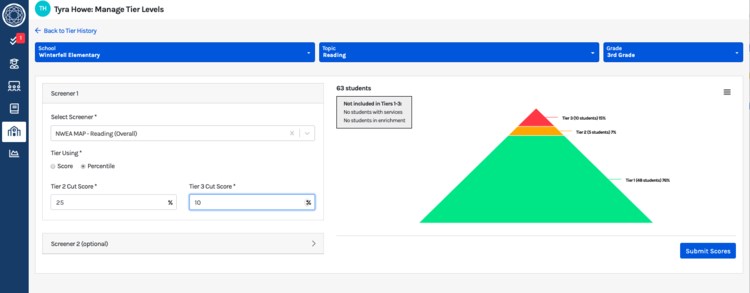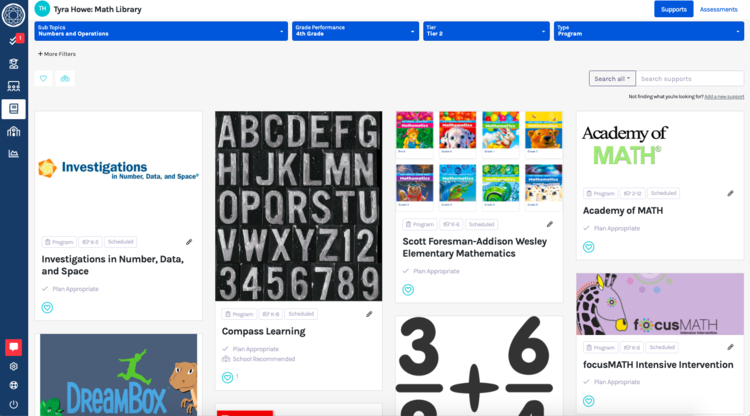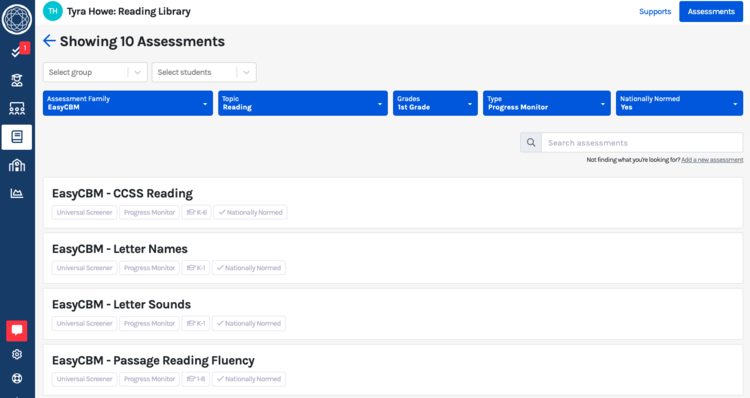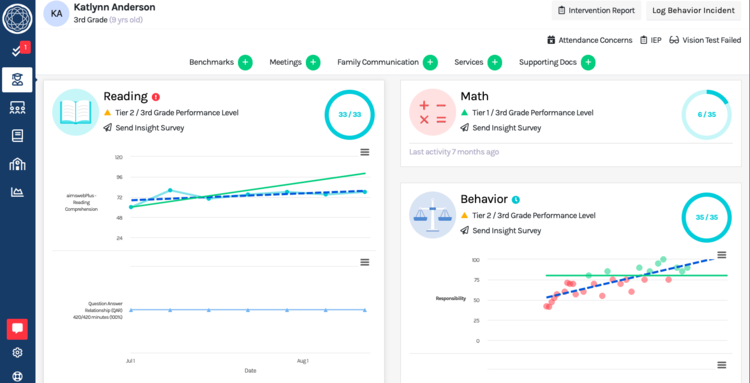
Now Is the Time to Invest in a Multi-Tiered System of Supports (MTSS)
How Can Schools and Districts Reduce the Damage of the COVID-19 Slide?
The COVID-19 global pandemic has created many unknowns for our education system. But one certainty is the challenge teachers will be faced with when students do return to the classroom. The good news is there are a number of things school and district leaders can do now to prepare for this new beginning.
While many school districts have made amazing efforts to continue student learning during this time, there is still an extremely large variation in the type of learning going on in students’ homes. Some students may be fortunate enough to have a parent available to work one-on-one with them and ensure they are completing their daily assignments; however, many students do not have this type of at-home support.
During this time, many students have also experienced caregivers losing their jobs, falling into poverty, and their loved ones getting ill, being hospitalized, or passing away. These traumas will undoubtedly affect their emotions, behaviors, and motivation when they return to the classroom. When schools reopen, teachers will be faced with classrooms of students with a vast array of experiences and academic, behavioral, and social-emotional needs.
So, How Can Schools and Districts Prepare Themselves and Their Staff?
The solution lies within a framework that many schools already use to support all students across levels of need. Multi-Tiered System of Supports (MTSS) is a system-wide approach to provide ongoing, targeted, interventions and support for students who are struggling. MTSS allows educators to proactively provide differentiated instruction depending on what a students’ needs may be. Even if this framework is already utilized in your district, now is the time to invest in high-quality, evidence-based tools to strengthen the MTSS practice and its effectiveness.
Step 1: Develop an MTSS Leadership Team and Handbook
When school is back in session who will guide teachers through their MTSS practices? Who will teachers look to for support when engaging in the problem-solving process? A strong leadership team at both the district and school level is the foundation of any healthy MTSS model. The district MTSS team can include program directors and coordinators who work with schools across the district. At the school level, teams should include interventionists, specialists, principals, and assistant principals who work directly with teachers and students within the school.
It's critical for these leadership teams to establish and/or adapt MTSS policies and guidelines, so this work can continue whether schools are opened or closed, providing synchronous or asynchronous instruction, either in-person or virtually.
If your district or school doesn’t have an MTSS handbook, now is a great time to work on clearly outlining your process. This will make it much easier for staff members to know what is expected of them and the steps and guidelines they should be following when implementing the components of MTSS.
An MTSS handbook should scope out how these processes and practices should be adapted to match your district’s various COVID-19 scenarios so that teachers can continue to collaboratively create and implement intervention plans, monitor progress, and assess goals. Finally, team members will be responsible for coordinating and implementing the remaining steps and clearly articulating each protocol to their staff.
Step 2: Invest in and Continue To Use a Universal Screener
When schools reopen, administering a universal assessment will be critical. If your school or district doesn’t already use a nationally-normed, evidence-based universal screener, now is the time to invest in that process. Leadership teams should also outline how they will use this data to tier students and what other information will be used to decide the level of support students need.
MTSS teams should also develop remote assessment plans in case schools remain closed for an extended period of time. Many screeners are delivered online, but if that is not an option for your district, consider training teachers on delivering basic skills assessments (e.g., oral reading and computation fluency) over video conference.
Many nationally-normed assessments include percentiles, in addition to raw scores, which schools can use to group students into tiers based on their level of performance. If your school or district has screener data from the 2019/2020 school year, those data points should be compared with the data collected at the beginning of the new school year to determine which students have fallen behind the most. It is expected that many students will show declines over the school closure period, thus looking at the trajectories of students is essential.
For more information, watch our webinar on how to use screening data to tier students in MTSS. In addition, The National Center for Intensive Intervention has screening tool charts for both academics and behavior.

The Branching Minds platform allows users to tier large groups of students based on results from universal screening.
Step 3: Ensure the Use of Evidence-based Interventions
Once you identify the students needing additional support, which programs, strategies, and tools will your staff use when they work with these students in small group and one-on-one settings? Start thinking now about the evidence-based supports your teachers will use for each topic area and across tier levels. It's important to identify interventions and supports that are backed by high-quality evidence.
While many schools often focus on reading interventions, recent long-term projections show that students are more likely to have steeper declines in math as a result of the extended school closures. If your district doesn’t have an evidence-based math program, now is the time to search for one that will meet the needs of your students. In the event that schools remain closed or have to re-close, teachers should have access to interventions and supports that can also be implemented remotely. For more information listen to our recorded webinar on successful intervention planning.

On Branching Minds, users can search the Supports Library for evidence-based programs and practices across topic, grade, and tier level. Interventions are also recommended based on student skill level and areas of need. Users also can search specifically for remote learning interventions and accommodations.
Step 4: Find and Continue Using Reliable and Valid Progress Monitoring Tools
To determine if teachers’ efforts are effectively impacting students, accurately monitoring student progress over time is essential. When progress monitoring isn’t done properly, students who are not responding to interventions can fall through the cracks and not get the support that they really need. If your district has relied on reading running records or teacher-made assessments up until this point, it's now even more critical to include progress monitoring tools that are backed by solid research and can objectively measure student growth.
Similar to benchmarks and universal screeners, some of these progress monitoring tools may be administered online. Teachers can also be trained to administer assessments virtually if needed. The National Center for Intensive Intervention has progress monitoring tool charts that provide the details for different assessments that can be used for academic tracking.

Users can search the Branching Minds assessment library to find reliable and valid progress monitoring assessments which can then be added to intervention plans for individual students and groups.
Step 5: Plan Your RTI/MTSS Meetings
Team problem-solving meetings are the place where all the components of MTSS come together to inform the decision-making process. Your first in-person MTSS team meeting may be months away, but that doesn’t mean you can’t get a headstart planning exactly how those meetings will be conducted. Because of the extended period of school closures, schools may have more students performing below grade level than normal. Therefore, these first meetings will need to be even more streamlined and data-driven than in the past in order to identify which students require support and what type of support they need.
To prepare, familiarize your team with problem-solving protocols and develop an outline for how each meeting will run, including who will be present, and what kind of data they will need to bring to these meetings. You can also watch our webinar from earlier in the year which outlines the components of effective MTSS meetings.

The Branching Minds platform brings together student data to help streamline MTSS meetings and inform the problem-solving process.
For more information on how to improve your district’s MTSS capacity and prepare for school openings, schedule a demo with one of our team members.
Learn more about how we can help
Branching Minds
Branching Minds is a highly respected K-12 services and technology company that leverages the learning sciences and technology to help districts effectively personalize learning through enhancements to their MTSS/RTI practice. Having worked with hundreds of districts across the country, we bring deep expertise in learning sciences, data management and analysis, software design, coaching, and collaboration. Combined with our extensive toolkit of resources, PD, and technology, we provide a system-level solution. We are more than a service or a software provider, we are partners who will deliver sustainable results for educators, and a path to success for every learner.
Related Posts
Tagged: MTSS Basics, MTSS Infrastructure




Comments (1)